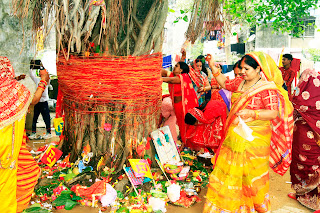Vat
Savitri Puja: A Celebration of Devotion, Love, and Tradition
By Ashok Karan | ashokkaran.blogspot.com
This
morning, during my usual stroll, I came across a beautiful scene — women
dressed in vibrant red and yellow sarees, adorned with traditional jewelry and
carrying bronze plates filled with puja offerings. They were headed towards the
temple, immersed in devotion. It was then that I realized: today is Vat
Savitri Puja — a sacred day observed by Hindu married women who fast and
pray for their husbands’ health, longevity, and prosperity.
A central
ritual of this puja involves circling a banyan tree seven times while tying
sacred cotton threads around it. This act symbolizes the wish for
“Saubhagyavati Bhava” — a blessing for an enduring marital bond and lifelong
fortune with one’s husband. For many Hindu women, this is not just a tradition
but a heartfelt prayer that binds love, loyalty, and spirituality.
Vat Savitri
Puja is deeply rooted in the legendary story of Savitri and Satyavan.
When her husband Satyavan collapsed and died under a banyan tree, Savitri’s
unshakeable devotion and wise reasoning moved Lord Yama, the God of Death.
Impressed by her resolve, Yama granted her wish and restored Satyavan’s life,
blessing her with a hundred sons.
Celebrated
on Amavasya (new moon) in the month of Jyestha, this vrat (fast) is a
key observance in Sanatan Dharma. It represents purity, spiritual strength, and
the transformative power of love and prayer. Women worship under the banyan
tree, offering prayers to Lord Vishnu, Brahma, and Mahesh,
seeking divine blessings for their family’s welfare.
This
festival, also known as Vat Purnima in some regions, is predominantly
observed in Western and Southern India. Newlyweds, in particular, show great
enthusiasm, as it marks their first Vat Savitri Puja — a memorable moment in
their marital journey.
In markets,
the energy is palpable. Shops brim with red sarees, puja items, cosmetics, gift
sets, and decorative accessories. Bamboo and palm leaf fans are sold at
₹20–₹50, intricately decorated baskets range from ₹250–₹500, and demand for
fruits and puja books (₹20–₹30) surges.
Beauty
parlors see long queues of women getting ready with makeup and mehndi
(henna) — a beloved tradition. Henna artists offer a range of beautiful
designs:
1.
Lotus motifs –
Delicate floral art around the wrist.
2.
Rose circle patterns – Romantic and festive.
3.
Leaf-centric designs – Nature-inspired elegance.
4.
Full-hand vine styles – Traditional and elaborate.
5.
Mandala art –
Intricate central designs on the palm.
6.
Minimal fingertip designs – Elegant and simple.
Prices vary
from ₹500 to ₹1500, depending on the design’s complexity. Women from affluent
backgrounds often opt for more elaborate patterns, adding to the richness of
this cultural celebration.
Vat Savitri
Puja is more than just a ritual — it is a heartfelt affirmation of love, faith,
and unwavering devotion. May every woman who observes this vrat be blessed with
happiness, peace, and a fulfilling married life.
Wishing
all married women a joyful, sacred, and prosperous Vat Savitri Puja. May the
bond of love and respect between you and your partner deepen with every prayer.
📷 [Image: Women worshipping under a
Banyan Tree on Vat Savitri Day]
Please like,
share, and subscribe to support and spread cultural awareness.
— Ashok Karan
#VatSavitriPuja
#HinduTradition #SavitriSatyavan #BanyanTreePuja #MarriedWomenVrat
#IndianCulture #PiousCelebration #WomensDevotion #HinduFestivals
#AshokKaranWrites



Leave a Reply